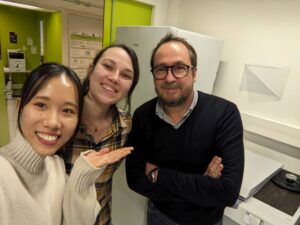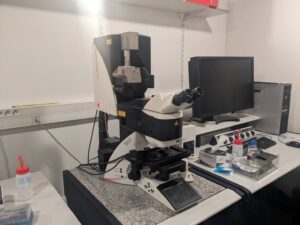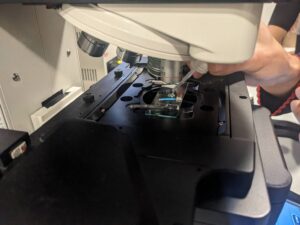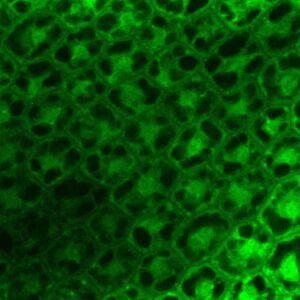We will post a report on the activities of two students who received overseas travel support from the Integrated Initiative for Designing Future Society in 2023FY.
It seems that the overseas training program was a great opportunity for future research and career development. We will continue this support system in this fiscal year.
—————————————————————————————————————————————————————————————
Report for overseas training supported by Integrated Initiative for Designing Future Society
“Building an international collaboration system in food function research to block the diabetes-dementia onset correlation”
Saya Nakamura
Food Science Group
Graduate School of Bioresource and Bioenvironmental Sciences
Kyushu Univesity
Activity for this training
From the end of September 2023, I stayed in Agriculture and Agri-Food Canada (AAFC), a Canadian government research institute located in Guelph, about an hour west of Toronto, Ontario, in central eastern Canada. It is still ongoing now.
First, at the end of September, I participated in the 3rd International Symposium on Bioactive Peptides held in Niagara Falls, Canada. At the conference, I had chances not only to give a poster presentation, but also to talk in 5-minute flash talk. In the flash talk, we must summarize our research content in a 5-minute oral presentation, including the background, results, and discussion, and must strive to convey the appeal of our research to promote the audience’s understanding. Although I unfortunately missed out on the presentation award, I could respond to several questions even though it was my first face-to-face international conference, and after presentation, I received compliments from many professors. At this conference, we not only gained cutting-edge knowledge about functional peptides, but also had the opportunity to discuss several aspects on this field with industry, government, and academia researchers from all over the world. In addition to researchers who are leading the functional peptide research around the world, I could create international research network with foreign doctoral students.
After conference, I conducted research under Dr. Cao at the AAFC-Guelph Research and Development Center (GRDC) (Photos 4 and 5). Dr. Cao is a authority on the antioxidant and anti-inflammatory effects of food factors, and under his guidance, I am now studying to utilize unused resources in Canadian agricultural products. Specifically, I visited the Harrow research and development center, one of the largest greenhouse research facilities in North America, which is part of the AAFC’s research and development network. There, I collected crop stems and leaves that cannot be sold on the market due to the lack of availability, and perform comprehensive profiling of the phytochemicals contained in these unused resources. Furthermore, we are conducting evaluations of the physiological effects of these resources, focusing in particular on their antioxidant and anti-inflammatory effects (Photos 6 and 7). Additionally, in carrying out my research project, I am also conducting to get skills for testing methods using cells for diabetes-induced intestinal inflammation as well as deepening my understanding of evaluation techniques and related knowledge in other related fields.
Achievement and future perspective
It was biggest benefit to build an international research network. In the international conference, I had research exchanges with leading researchers in functional peptide research as well as doctoral students from overseas universities. I am conducting research at a government research institute, the GRDC. This institute is adjacent to the University of Guelph, which is one of the top universities in the field of agriculture, and joint research is actively conducted there. Since Dr. Gao’s laboratory has a PhD students from the Food Science Department at the University of Guelph, I could hear lectures and doctoral thesis hearings held by the Food Science Department, as well as scientist exchange events sponsored by the university. At the IUPAC World Women’s Breakfast held at the University of Guelph at the end of February, women in STEM fields (Science, Technology, Engineering, Mathematics), I was able to interact with researchers, and it gave me an opportunity to reconsider career development for women in academia. Through international researcher exchanges that are not limited to these fields, we are striving to build an international network for future research activities (Photo 7). Through these exchanges and research activities overseas, I was able to touch research activities. I am also confident that the network I have built this time will be of great help to me in my future activities as a researcher. Furthermore, by conducting research at AAFC, a Canadian government research institute rather than at a university, I was able to realize the importance of research that considers the needs of producers (farmers and food manufacturing sites) in Canada, an agricultural powerhouse. This made me aware of the difference between university research and government research institute, and it was an important experience when thinking about my future career. Also, while conducting research activities at GRDC, I felt a big difference in the research environment between Kyushu University and GRDC. There may be a difference between university research and government research institutes, but unlike Japanese laboratories, GRDC has an established division system of labor. There are support systems for experiments, including on-site technicians to manage and operate large equipment. In the research environment at a Japanese laboratory, I was able to conduct all steps in research by myself, from research planning to experiments and analysis, which deepened my understanding of each experiment and result and broadened my range of experience. Through the research division system, I have more time to focus on my own data and the overall picture of my research theme, and I feel that this has led to the development of a broader and bird’s-eye view.
Currently, I am working hard to write papers on my research themes and receiving corrections from researchers whose native language is English, while conducting experiments
In addition, I have plans to continue to actively participate in doctoral thesis at the University of Guelph, AAFC and university seminars, and will develop a multifaceted and international perspective in my research activities. Through this study abroad program, I would like to work even harder and be more conscious of the impact that my future research results will have on society and the world.
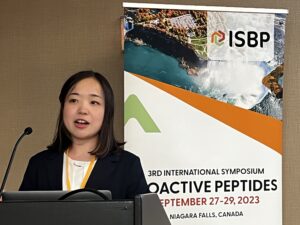
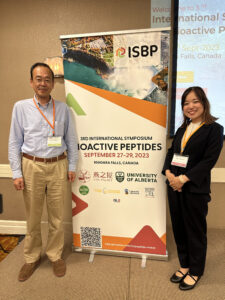
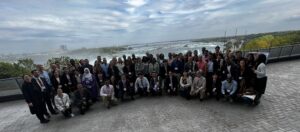
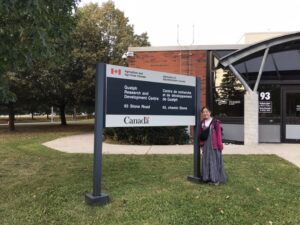
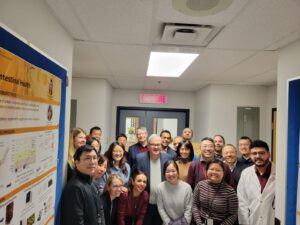
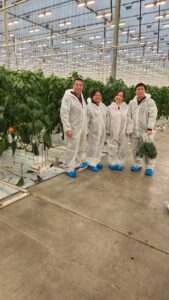
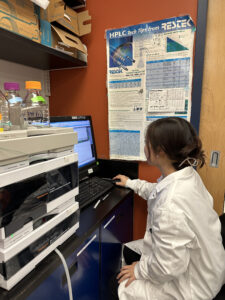
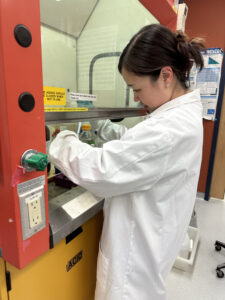
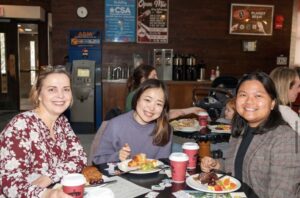
“Research activity at Sorbonne University”
Rikako Saratani
Agricultural Production Group
Faculty of Agriculture
Kyushu Univesity
From January 8 to February 7, 2024, I stayed in Seed Biology Laboratory at the Sorbonne University in Paris, France under the support by Integrated Initiative for Designing Future Society in Kyushu University. I will describe the report in three sections: “Research Topics and Circumstances Leading up to Overseas Travel,” “Activities, Results, and Future Prospects,” and “Impressions through Activities.”
Research topics and circumstances leading up to overseas travel
I am a fourth-year undergraduate student in the Crop Science Laboratory of Faculty of Agriculture. The Crop Science Laboratory aims to “understand the response of crops to environmental changes and improve yield and quality,” and handles rice, wheat, soybean, and cowpea as experimental materials. I am mainly conducting research on seed germination of wheat, with the aim of solving the problem of viviparous seed germination (Phenotype of seeds germinating prematurely while they are still inside or attached to the parent plant or fruit), which is a problem of wheat. Among the several factors that affect germination, we focus on substances called reactive oxygen. Reactive oxygen species (Reactive oxygen species; ROS) is a substance with strong oxidizing power, such as hydrogen peroxide and superoxide, and is generated in the process of various biological processes. In general, it is a substance that causes harm to living organisms, but it is known that active oxygen acts as a dormant breaker in seed germination and promotes germination. Currently, there are many questions about reactive oxygen on seed signaling, and it is necessary to elucidate the seed germination mechanism by reactive oxygen species in order to solve the problem of viviparous seed germination, which impairs the quality and commercial value of wheat.
The Seed Biology Laboratory at the Sorbonne University studies seed germination and dormancy at molecular and cellular level, and has published numerous papers in academic journals. In addition, our laboratory is a joint research partner, and is a group of 14 people, including 5 supervisors, 6 graduate students and above, and 3 technical staff led by Professor Christophe Bailly. Prof. Christophe Bailly has studied the role of reactive oxygen species on seed germination and dormancy, and I decided to study abroad with the aim of “investigating the intracellular localization of reactive oxygen species related to seed germination,”.
Activities, results, and future prospects
In this study, I tried to get fluorescence images for reactive oxygen in Arabidopsis embryos using a confocal microscope. Confocal microscope is a type of laser microscope that can take fluorescence excited by a laser to create images. The biggest advantage of this microscope is that it can obtain 3D images due to the high resolution of the Z-axis. With this advantage, we were able to observe the localization of fluorescence in inner tissue. After about one month of experiments, we learned experimental methods and found the hypothesis we made in our laboratory was supported in Arabidopsis seed embryos.
In the future, I would like to go on to graduate school at the university’s Crop Science Laboratory and conduct similar experiments using wheat to investigate the intracellular localization of reactive oxygen species and further elucidate the mechanism of seed germination.
Impressions through activities
One of the impressive things is that I was asked for my opinions. Just after arriving in Paris, I was talking with Professor Christophe Bailly about my plans for the next month, I used the words “My laboratory” and “Professor” as the subject when explaining experiments and hypotheses. Then Professor Christophe Bailly said, “What are your opinion? Not your supervisor.” Laboratory members also listened to my opinions and gave me many opportunities to make my choices during the experiment. Through these situations, I realized once again the importance of expressing my opinions and verbalizing them.
When I first came to France, I felt a strong language barrier and struggled to understand what was being explained, but gradually I began to communicate with members, even if it was poor English, when I had questions or opinions. I feel that this has become one of my strengths because I have been able to continue doing this even now that I have returned to Japan
Finally, I would like to express my gratitude to everyone involved for giving me such a valuable experience.
